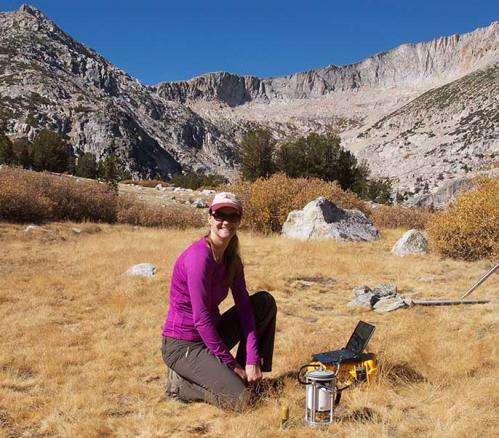Drying Sierra meadows could worsen California drought

Carpeting the high valleys of Yosemite and other parts of the Sierra Nevada, mountain meadows are more than an iconic part of the California landscape. The roughly 17,000 high altitude meadows help regulate the release of Sierra snow melt into rivers and streams.
But climate change and California's severe drought threaten to permanently alter these fragile and important ecosystems, according to research by Chelsea Arnold, who was awarded a doctorate in environmental systems from UC Merced in May. Her findings reveal that soil changes already are taking place that could have long-term implications for California's water supply.
Impact of extreme weather
Arnold's research found that meadows in the Central Sierra near Yosemite are drying out as a result of several years of unusual variation in climate and snowfall.
"What we're seeing is that all kinds of extreme weather, including one dry winter like the one we just had, can totally change the structure of the soil," Arnold said. "Part of that is an irreversible change."
Under normal conditions, a mountain meadow acts like a sponge. Organic material in the soil allows the meadow to hold water, which is filtered and slowly released to mountain streams. Samples collected by Arnold and her colleagues found that the larger pores which trap and hold moisture are disappearing, to be replaced with smaller, more compact pores through which water doesn't easily flow.
As meadows dry out, flooding in wet years is likely to increase. And in drought years, parched meadows could result in less snowmelt reaching streams, exacerbating the state's already precarious water situation.
Arnold said that the changes won't be easily remedied. Mountain meadows may act like sponges, but unlike a dry sponge, their ability to hold water isn't reversed when the soil becomes re-saturated.
"It's like with a raisin. You can add water, but all you're going to get is a soggy raisin," Arnold said.
Protecting a beloved back yard
Arnold's interest in Sierra ecosystems is personal as well as professional. The Santa Rosa native spent every summer since she was 2 in the Yosemite backcountry, and has worked as a backcountry guide for more than a decade.
A former schoolteacher who lives in Mariposa with her husband and two children, Arnold is still actively engaged with K-12 education. She currently serves as interim director of Merced's CalTeach program, a UC program that introduces undergraduates across the university to careers as classroom educators. She also still spends a good bit of time in the classroom, helping students learn about the region's geology, soils and ecosystems.
"Students aren't exposed to careers in geosciences as much as, say, biology," she said. "Everybody wants to be a doctor. But I love the geosciences, and I feel that if we expose students to environmental careers, they'll have a broader sense of all the things that are possible."
An ecology marked by boom and bust
California hydrology has always been a boom-and-bust affair, marked by wet years when millions of acre feet are "wasted to the sea," in the words of old-school Californians, and drought years when conflict erupts over how to divvy scarce water supplies.
Those two extremes have been more prevalent in recent years, with especially violent whipsawing of precipitation and temperature in the Sierra range.
The snow pack was 156 percent of normal in the winter of 2010-11, the seventh wettest year on record in Yosemite.
The next two winters were warm and extremely dry: 2011-12 was the fifth-driest year on record with snowpack at 49 percent of the average; and 2012-13 was the driest year since record-keeping began in 1929, with the snowpack at 25 percent of average and no snow until January..
"Meadows rely on snow to insulate them over the course of the winter," Arnold said. The snow cover keeps the soil moist and protects it from temperature extremes.
Without that insulating cover, meadows last year lost a significant amount of moisture in mid-January, when temperatures suddenly dropped and snow fell on dry soil. Then snowmelt came earlier than usual, on May 5.
"These wild, extreme years we've had are having an effect," Arnold said.
Arnold points out that are efforts are underway to preserve meadows throughout the Sierra. She hopes that her research will help inform that work.
But, as unseasonably wet or dry years become more common, it also will be important for officials to understand the limits of such efforts.
Like it or not, accounting for the long-term changes underway will be critical to managing the state's water supply—not only in the wake of this drought, but for years to come.
"The restoration of these meadows is seen as a potential strategy for increasing water supply," Arnold says. "But the meadows really don't work that way."
Provided by University of California - Merced


















